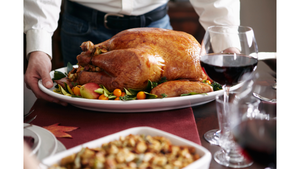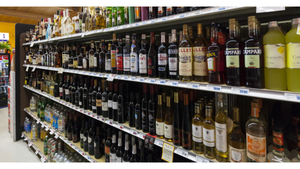FLORIDA CITRUS LOOKS GOOD, MAY BOOST JUICE VOLUME
LAKELAND, Fla. -- There will be plenty of fresh Florida citrus products and juices on retail shelves this winter, say officials with the Florida Department of Citrus, responding to federal harvest estimates.The 2000-2001 Florida citrus crop is forecast to hit 240 million boxes of oranges, a 3% increase over last year, according to the U.S. Department of Agriculture, Washington.This year's big yield
October 23, 2000
ROBERT VOSBURGH
LAKELAND, Fla. -- There will be plenty of fresh Florida citrus products and juices on retail shelves this winter, say officials with the Florida Department of Citrus, responding to federal harvest estimates.
The 2000-2001 Florida citrus crop is forecast to hit 240 million boxes of oranges, a 3% increase over last year, according to the U.S. Department of Agriculture, Washington.
This year's big yield is due to a larger crop of Valencias, the primary source for not-from-concentrate juices, according to Dan Santangelo, FDOC executive director.
"Here in Florida, nine out of 10 of our oranges end up in juice, so we think this is a real manageable crop," he said.
Other citrus categories are not expected to fare as well: USDA estimates put the grapefruit harvest at 50 million boxes (down 6% from 53.4 million boxes packed during the 1999-2000 season), and specialty citrus like tangelos will decrease 9%, from 11.3 million boxes last year to 10.3 million this season.
Santangelo noted that the jump in Valencias is a well-timed boost to the NFC orange juice category, where per-capita consumption has reached 5.9 gallons, nearly an all-time high.
"The most recent ACNielsen data showed a 3.5% increase [for the period ended Sept. 30, 2000], and that's against almost a 5% increase the prior month," he said. "Sales continue to be robust and we continue to build momentum."
Part of the rise can be attributed to growth in the number of retail channels selling orange juice. Santangelo cited statistics showing that NFC sales are up some 16% in drug stores and nearly 12% in mass merchandisers like Wal-Mart.
This increase in consumption and demand is reflected at the retail level by a corresponding rise in shelf space devoted to NFC juice. A recent study by the FDOC found that an average of 40 linear feet is dedicated to NFC products, double the space in 1995 and up 13 feet from 1998.
"Everything that we see suggests that orange juice consumption is expanding," he said. "We're looking at a major push in our program and to perhaps even run a sale this winter on the larger sizes."
Santangelo said that the agency's research indicates that consumers are drinking a gallon of NFC juice in the same time period as they would a half gallon. So, any promotion would focus on the 96- and 128-ounce size containers sold at retail.
"[Those sizes] are currently one-third of all the orange juice volume sold," he noted. "So, a continued push on upsizing is very important."
Even smaller sizes might see additional increases in the coming year, as processors start to package the product in handheld, portable containers that go with lunch bags or fit into cupholders of motor vehicles, he said.
According to Santangelo, grapefruit juice sales continue to be "soft," and declined 20% as of Sept. 30. Prices increased 10% over the same period, he said. But, a new round of promotions this year that includes smart coupons could revitalize category sales.
"[Grapefruit growers] started to husband inventory last year because they thought there was going to be a big shortage," he said. "Prices were raised and promotions were pulled. We've just launched a full-court press this past week to try and turn this around."
With orange juice leading the way, the agency reported success with a West coast campaign directed at large population centers like Los Angeles. Santangelo said the promotion sought to boost sales in the region, where consumption was 30% below the national average. Citing the latest Nielsen data, he said there has been a nearly 12% increase in overall orange juice movement in the West, while product specifically from Florida enjoyed an 18% jump.
The marketing plan for 2000-2001 will continue to stress the health aspects of citrus consumption, incorporating the participation of the American Heart Association, the American Cancer Society, the March of Dimes and the American Stroke Foundation, which released a report last year suggesting consumption of citrus products could help in reducing the chance of stroke by up to 30%, Santangelo said.
"We're encouraging consumers to support daily consumption and to trade up to larger sizes," he said. "We're finding that people who hear and accept these messages are consuming 20 gallons per capita."
Fresh product is also getting attention, Santangelo said. One highlighted program that's already received the approval of more than two dozen retailers creates "Florida sections" of up to 16 feet in length in the produce aisle. The plan includes "major" early-season specials, consumer contests, a recipe/diet focus during mid-season and an end-of-season emphasis on salads containing fresh citrus.
Santangelo said the ongoing citrus canker epidemic in the Sunshine State is not expected to impact the 2000-2001 harvest figures, since the scope of the disease has already been factored into the forecast. He noted canker does not affect fruit quality, though it is devastating for growers. An infected tree creates a quarantine zone of 1,900 feet in circumference, and all trees and fruit within that radius must be destroyed through burning.
About the Author
You May Also Like




